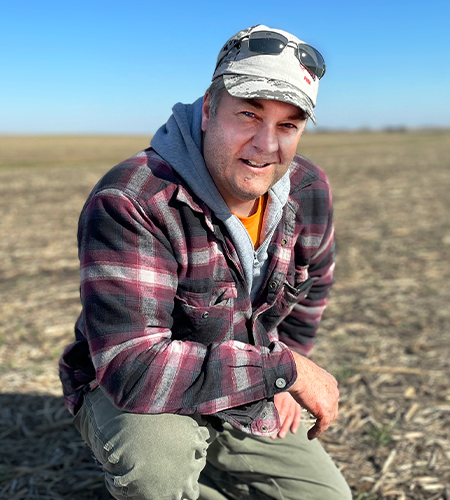I didn’t like putting the tillage tool in the ground and watching the soil ride away with a heavy rain event. I like the positive effects of no-till, strip-till and cover crops. This system keeps the soil where it belongs.

Dale Launstein
Launstein Farms
Grundy County

Farming Operation
- Third-generation corn and soybean farmer in Central Iowa who farms with his brother, John
- Rents approximately 75% of the land from four different entities
- Owns and operates two large hog finishing operations
- Uses hog manure to build soil fertility levels
- Grows some waxy corn for the food industry
4R Plus Practices Used
- Strip-tills corn and no-tills soybeans into cornstalks and rye
- Plants cover crops on all acres
- Experimenting with tillage radishes in cover crops
- Installed waterways to keep soil from moving
- Soil tests every four years
- Tests hog manure every year to determine application levels
- Split nitrogen applications on corn-on-corn acres
Results Seen
- Change in tillage practices keeps soil where it belongs
- No-till and strip-till have improved water absorption; is further enhanced by cover crops
- Experiencing less soil compaction and increased organic matter
- Cover crops provide better emergence and stands in corn
- Cover crops suppress weeds and salvage nutrients
- Split nitrogen applications puts manure out later at the base of the plant versus loading it up early
Plans for the Future
- Improve timing accuracy of terminating cover crops on lighter soils to maintain residue
- Protect his owned and rented ground and continue improving soil structure
- Continue to attend in-person and virtual soil health meetings
Click here to ask Dale Launstein a question about the farming operation.
Harvest 2021: 4R Plus Practices Can Weatherproof Crops
Dale Launstein of Grundy County is reaping the rewards of 4R Plus practices like strip-tilling corn, no-tilling soybeans into cornstalks and planting cover crops on all acres. With 60% of his corn crop harvested as of late October, Launstein was averaging around 245 bushels per acre.
Soybeans were also doing well, with harvest nearly complete and Launstein reporting an average yield of 80 bushels an acre. He waited until rye was hip-high to terminate it for added weed control.
Click here for the full story.
Summer 2021: Planting Green into Cover Crops, Now Praying for Rain
Grundy County farmer Dale Launstein’s planting season went fast. His no-till soybeans were planted by late April, and he finished planting strip-till corn the first week of May.
He planted everything into green cover crops, with the rye nearly waist high in some fields. “We waited for the rye to die before planting the non-GMO corn,” he said. “We planted the commercial corn and waited about a week to 10 days before we terminated. I’ve got a little smorgasbord going on this year.
Click here for the full story.
Spring 2021: Protect Productive Soil Using 4R Plus Practices
Dale Launstein of Grundy County is willing to go to great lengths protecting the productive soil he raises corn and soybeans on. About 25% of the ground is highly erodible, but the rest is mostly flat.
“I personally have trouble watching a farm get mistreated through tillage and watching the soil wash away with a heavy rain,” he said. He and his brother, John, have been experimenting with conservation tillage for 25 years. They settled on no-till for soybean ground and strip-till for corn.
Click here for the full story.
